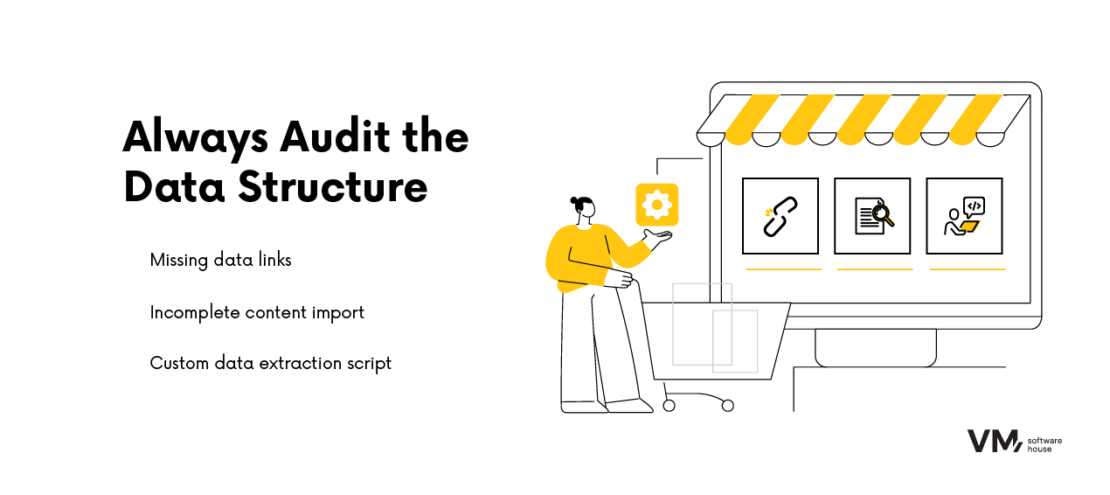
Implementing a chatbot isn’t just about installing a plugin or knowing the right tech stack. It’s a process that involves data quality, solid architecture, testing, security, and clear expectation management.
Based on our own implementations and conversations with AI experts, we’ve compiled a set of practical insights. These tips will help not only when designing website chatbots but also when developing other types of AI agents.
Table of Contents
Always Audit the Data Structure — Tech Knowledge Isn’t Enough
Being familiar with WordPress or other platforms doesn’t guarantee that your data is clean or structured correctly. In one of our projects, the initial data import failed — only 70% of the content was extracted, and key relationships between headers, case studies, and page sections were missing. Manual indexing and a custom extraction script were required.
Tip: Before building your bot, spend 2–3 hours analyzing the client’s data structure in detail. This lets you clearly explain the current state and highlight what needs to be fixed.

Make the Client Accountable for Their Data
Even the smartest AI can’t give good answers without accurate and complete data. Ultimately, it’s the client’s responsibility to ensure content readiness. It’s critical to clarify this upfront — otherwise, the implementation team may get blamed for missing information, causing delays and confusion.
Tip: From day one, emphasize that the client is 100% responsible for the content — both on the website and in any supporting databases. Ideally, designate one person on their team to own data quality and maintenance.
Plan for at Least 4 Weeks of Intensive Testing
Automated tests are useful, but real value comes from content-based testing. That’s when gaps are discovered — questions the bot can’t answer or answers that are inaccurate. Importantly, these tests require active client involvement, and this should be communicated clearly at the beginning of the project.
Tip: Allocate at least four weeks for user testing. Apply the 80/20 Pareto Principle — launching the bot is just the start, while fine-tuning can take months. Don’t aim for perfection; the chatbot’s strength lies in speed and cost-effectiveness, not omniscience.

Avoid Hardcoding Questions
It’s tempting to hardcode a few answers during bot development — just add a canned response and move on. But this approach creates long-term problems.
Even a single hardcoded answer can disrupt the bot’s overall logic. Why? Because manually inserted responses often surface where they don’t belong.
Tip: Build a strong FAQ section and let the bot use content extraction mechanisms. This makes the answers contextual, dynamic, and personalized — not rigid script playback. A chatbot’s purpose is to select content intelligently based on the conversation, not follow a fixed scenario.
Customize Security Filters for Each Project
There’s no one-size-fits-all approach to chatbot safety. An internal tool for developers needs different filters than a public-facing support bot. Start each project by aligning with the client on what types of content should be permitted or blocked — profanity, off-topic questions, or industry-specific sensitive phrases.
Tip: Have a detailed content safety discussion with the client to define acceptable and blocked topics from the start.

Match AI Models to Specific Tasks
Not all AI models are built for every use case. For instance, GPT-4.1 Mini may be great for quickly classifying questions, while GPT-4.1 is better suited for in-depth responses based on a knowledge base. Using different models for different layers of logic yields the best results — fast reactions for simple queries, and rich answers when depth matters.
Tip: Don’t overload one model — leverage each model’s strengths where they provide the most value.
Combine Multiple Knowledge Sources
A chatbot should never rely on a single data source. The best results come from combining multiple types of content:
- Prompt-based data – Ideal for static facts (e.g., company address).
- Text files – Great for frequently updated content (e.g., promotions).
- Vector databases – Best suited for large, rarely changing knowledge bases.
Tip: Don’t limit yourself to one source. A hybrid knowledge system ensures more flexibility and resilience against errors.

Treat the Bot Engine as a Standalone API
One of the smartest design choices? Separate the bot’s “engine” from any specific website. This makes your chatbot platform-agnostic — it can draw from multiple data sources and operate across channels like a website, MS Teams, or even Drupal.
Tip: Build your chatbot modularly and expose it via API. This gives you long-term flexibility, easy scalability, and fewer headaches when platforms change or new channels are added.
Monitor, Collect Feedback, and Evolve With the Bot
An AI chatbot is not a “set-it-and-forget-it” tool. It evolves alongside your users. Without monitoring and user feedback, its development turns into guesswork.
At the beginning, a simple Excel file or chat logs from the admin panel are enough. As your system matures, consider analytics tools (Grafana, Datadog), rating systems (thumbs up/down), or error reporting features.
Tip: Monitoring and feedback aren’t optional extras — they’re critical to progress. They turn your bot into a continuously improving asset.
Manage Client Expectations Around AI Bots
It’s easy for clients to compare a custom chatbot to general-purpose tools like ChatGPT or Gemini. But that’s misleading — and your job is to set the record straight early on.
The first versions of a chatbot typically rely solely on content from the client’s site: service descriptions, case studies, blogs, FAQs, and company info. That means the bot will answer questions in this scope very well — but won’t be equipped to go far beyond it.
Large language models (LLMs) are context-aware — they can hold long conversations. But every extra turn adds computing cost. For website bots, especially in early phases, memory is often limited to 2–3 exchanges. It’s a deliberate trade-off: focused, faster, and lower-cost interactions that still deliver value. Memory can always be expanded as the project — and budget — grows.
Tip: Keep these limitations in mind — and know where they come from.
Remember: A chatbot is not a One-Off Launch. It’s a living system — just like a team member. It requires attention, updates, and continuous improvement.
Want to discover how an AI chatbot can actually streamline your business? Let’s talk — we’ll help you design a solution tailored to your needs and budget.













